
Developments in technology, the expansion of mobile networks, and the decreased costs of internet-enabled devices: What do these have in common? Each contributes to how more people around the globe obtain internet access every year.
With a world population of more than 8 billion people and connectivity becoming increasingly essential for communication, access to medical resources, and the distribution of accurate information, everyone on earth deserves affordable, reliable, and secure internet access.1
Convenient internet access drives modern eCommerce, informs citizens during elections, and connects people who may have otherwise felt excluded from global conversations. With the rapid expansion of global internet access, it may surprise you that many of the world’s population still lacks reliable connectivity.
The statistics show incredible progress, but at the same time, some areas of the world need more and better access to the internet. To learn more about the current status of internet access worldwide, explore our 21 head-turning statistics on internet access.
1. More Than 4.7 Billion People Use the Internet Globally
Expert analysis estimates that close to 60% of the world’s population has access to the internet. That accounts for more than 4.7 billion people.
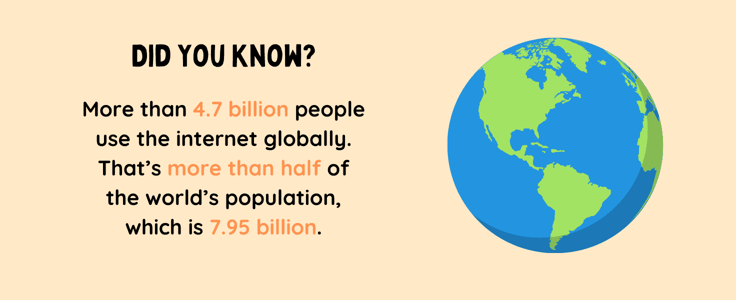
Asia has the majority of internet users, while Europe and North America trail far behind. Africa and South America make up the lowest concentration of internet users, but in recent years, Africa has approached similar numbers as North America.10
2. Bulgaria Has the Highest Percentage of People (29%) Who Have Never Accessed the Internet
Many people fall under the category of light internet users or even those who rarely connect to the internet. However, some people have actually never used the internet their entire lives.
This is particularly common in countries such as Bulgaria, where 29% of the population claims to have never accessed the internet.
Central Greece also has a high rate (28%) of people who have never used the internet. Other notable countries that lack access to the internet include Italy, France, and Turkey.9
3. China (1.05B), India (692M), and the United States (311M) Have the Largest Digital Populations
With more than 1.05 billion people connected to the internet, China has the highest number of internet users in one country.2 It overshadows the second and third largest digital populations: India and the United States.
India boasts 692 million internet users, while the United States has just more than 311 million. The numbers make sense since those countries have the highest populations in the world (in that order).
Yet, countries with high internet access rates also benefit from localized technology communities, tech-savvy citizens, and participation in global eCommerce.
Take Brazil, for instance; it actually has the seventh largest population but ranks as the fifth most connected country, thanks to elements like global trade and a solid tech community.3
4. Around 91% of Teen Boys in the U.S. Access the Internet Through Gaming Consoles, While Girls Report Higher Usage Rates on Computers (95%)
American female teens access the internet more regularly than their male counterparts. Yet the numbers tell a different story when looking at the types of devices used.
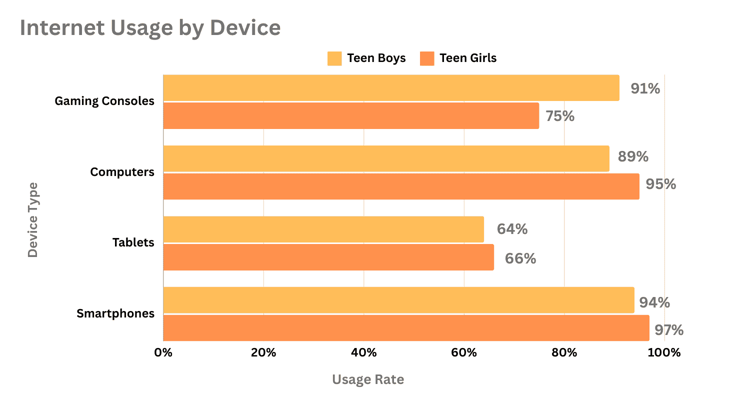
Yes, teen girls access the internet more than boys on smartphones (97% vs. 94%), computers (95% vs. 89%), and tablets (66% vs. 64%), but internet usage skyrockets for teen boys when it comes to gaming consoles.
In fact, 91% of boys connect to the internet via gaming consoles, compared to 75% of girls.5
5. North America (91%) and Europe-Central Asia (86.5%) Boast the Highest Per-Capita Percentages for Internet Usage
China and India have large populations, so it makes sense why internet usage numbers in those countries are so much higher than in other countries. However, North America and Europe lead the way in the share of a region’s population that uses the internet.
In fact, 91% of the North American population accesses the internet, while 86.5% of people in Europe and Central Asia use the internet. In East Asia, 69.1% of the population use the internet, and in South Asia, the share of the population using the internet is 38.5%.
Sub-Saharan Africa has the lowest share of people accessing the internet at 29.3%.11
6. In the U.S., 96% of Every Age Group Uses the Internet — Except for Those 65 Years and Older
U.S. 30-to-49-year-olds have a near-universal (98%) connectivity rate. That drops to 97% for the 18- to 29-year age group and 96% for everyone between 50 and 64 years of age.
Those above the age of 65, however, are slower to adopt the internet like the rest of the country.
Only 88% of 65+ adults in the U.S. use the internet. That’s still a high number compared to the rate of internet use among this age group in other countries, but it shows how those who, perhaps, hadn’t grown up with the internet are less likely to embrace it in their later years.4
7. At Least 15% of U.S. Adults Only Access the Internet on Their Smartphones
The smartphone has replaced the computer for many online tasks, but it may surprise you how many people skip home broadband internet altogether.
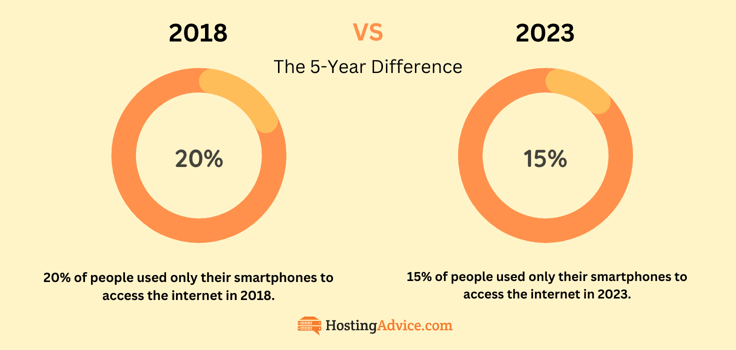
Smartphone-only internet users are those who don’t subscribe to home broadband and rarely use a laptop or desktop computer.
This also means these adults may rely solely on cellular data to access the internet. This trend has varied over the years; 20% of U.S. adults surveyed identified as smartphone-dependant in 2018, but that fell to 15% of U.S. adults who did so in 2023.6
8. Afghan Women Experience Extreme Levels of Internet Restriction, With Only 6% of the Female Population Having Access to the Internet
A digital divide between men and women in Afghanistan has existed for decades, but that situation worsened once the Taliban regained power in the country after 2021.
About 25% of Afghan men enjoy access to the internet. In comparison, only 6% of Afghan women can access the internet. The numbers drop further in rural areas, where only 2% of women have internet access.8
9. Roughly 99.9% of China’s Internet Users Access It Using Smartphones
Internet users in China, one of the most smartphone-reliant countries, almost unanimously rely on smartphones in some way to access the internet.
Desktop usage in the country drops dramatically compared to usage on smartphones, seeing as only 33.9% of internet users in China tap into the internet with a desktop computer.
Laptops get even less use (30.3%) in China, while users in China turn to TVs (22.5%) and tablets (26.6%) for internet access with even less frequency.12
10. About Two-Thirds of the Global Population Use a Mobile Phone, but Not Always for the Internet
The number of unique mobile phone users worldwide has grown to 5.65 billion. However, a mobile phone doesn’t imply internet access.
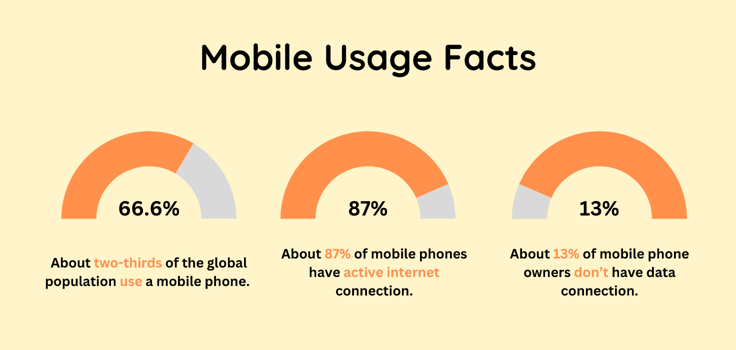
It’s a good start to increasing connectivity globally, but only about 87% of those active mobile phones have an internet connection. Therefore, the other 13% of cellphone users simply make phone calls and texts with them without a data connection.13
11. Only 39% of the Populations in Landlocked Developing Countries Connect to the Internet
Not surprisingly, the least developed countries have much lower internet access percentages than developed countries.
But the statistics improve for developing countries with landlocked borders, perhaps because they have surrounding support from more developed countries.
Least developed countries, identified by the United Nations as countries that exhibit the lowest indicators of socioeconomic development, report 35% internet access rates, while landlocked developing nations have a 39% internet access rate.16
12. Urban Households in the U.S. Have Internet Access at a Much Higher Rate (86.3%) Than Rural Households (81.3%)
Geographic context plays a significant role in the internet access divide, even in countries with high internet access rates.
For example, in almost every geographic region of the United States, urban residents report significantly higher levels of broadband subscriptions and internet connectivity than those living in nearby rural areas.
The only exception is the Northeast, where rural residents are more likely to have internet access and broadband subscriptions than residents in neighboring urban areas. Notably, the internet access divide between urban and rural households is much larger in the South.14
13. In the United States, 97% of Children Between 3 and 18 Have Some Sort of Internet Access at Home
Children and teens have staggering internet access rates in the United States. Those between 3 and 18 can connect to the internet at home 97% of the time, according to survey results.
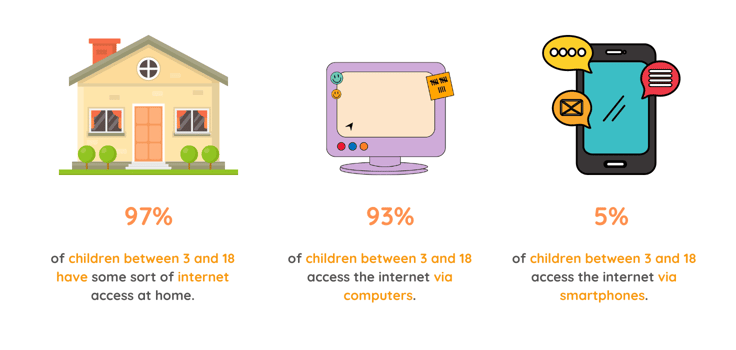
The device matters, however: Internet access for children and teens comes via computers 93% of the time. Smartphones for children 3 to 18 are far less prevalent at only 5%.
Studies show that smartphone connectivity in this age range has actually decreased since 2016.15
14. Around 46% of U.S. Teens Say They Use the Internet “Almost Constantly”
Almost half of the American teen population claims to use the internet “constantly,” showing what many consider a problem with addiction to technology, especially for young users.
The numbers change depending on ethnicity, household income, and gender. Lower-income households have teens with higher rates of “constant” internet usage, reaching 54% for households with incomes below $30,000.
In addition, 54% of Black teens and 55% of Hispanic teens report using the internet “constantly,” compared to 38% of white teens. Girls (47%) also said they have more trouble staying off the internet than boys (45%).5
15. Wealthier and More Educated Parents Most Often (99%) Give Their Children Access to the Internet
Although U.S. teens with lower-income parents more frequently report using the internet “almost constantly,” they’re actually given fewer opportunities to connect to the internet.5
Parents in the highest quarter of income report giving their children 3 to 18 internet access 99% of the time. Those numbers drop with every quarterly decrease in income level (mid-high quarter, middle-low quarter, and the lowest quarter).
Parents in the lowest income quarter said they provide their 3-to-18-year-old teens with internet access at a 94% rate.
A parent’s education level was a factor in survey results. Those parents with bachelor’s degrees or higher said they provided internet access to their children far more frequently than those with some college, a high school diploma, or no high school diploma.15
16. Households With at Least One Member Suffering From a Physical or Mental Disability Have Lower Rates (76%) of Internet Connectivity
Having someone at home with a physical or mental disability decreased the frequency of a household’s computer ownership and broadband subscription. These households reported owning a computer 84% of the time and having broadband subscriptions 76% of the time.
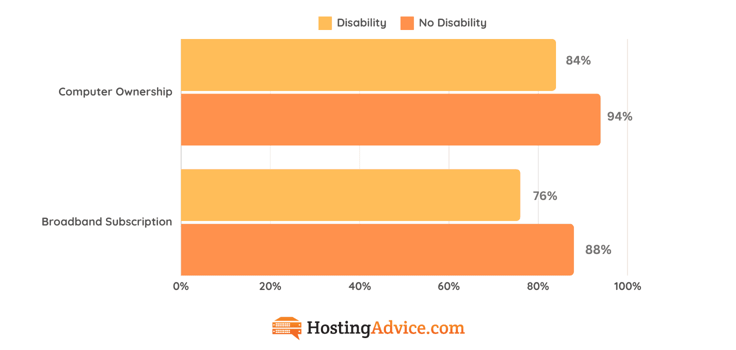
That compares with a 94% computer ownership rate and an 88% broadband subscription rate among U.S. households that did not have a member suffering from a mental or physical disability.14
17. During the COVID Pandemic, Internet Access Rose 10-14% in Five Sub-Saharan African Countries
South Africa, Senegal, Guinea, Sierra Leone, and Nigeria made up the five Sub-Saharan African countries with significant boosts in internet access during the COVID-19 pandemic.
South Africa saw the greatest change of 14%, bringing internet access to 66% of the country. The trend was most prevalent among older, employed female South Africans. In Nigeria, adoption took place mostly among men and youths.7
18. Internet Access Rates in High-Income Countries Will Likely Never Reach 100%
Some people will simply never want to connect to the internet. In addition, an older demographic may actually turn away from the internet as they transition out of the workforce.
When looking at the collection of countries considered developed, 93% of those populations are already online. That percentage increases slowly each year, with an annual growth rate below 1%.
Experts argue that internet connectivity in any country will never reach 100% because some people don’t want or need it.16
19. Connecting to the Internet With Wearables Has Increased 8% Over the Past Five Years, but the Smartphone Still Leads the Way
Internet connectivity with wearables — smartwatches, rings, and even glasses — grew by 8% among American consumers in 2017 from 1% just two years earlier.
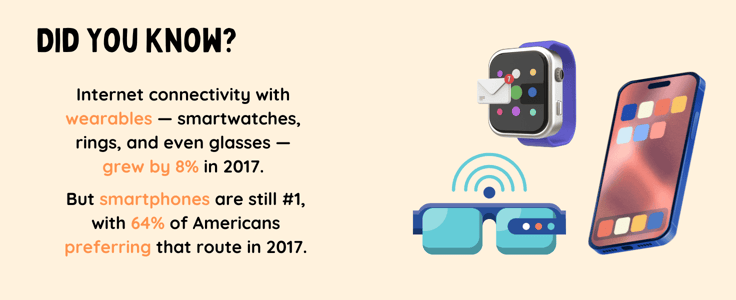
Connecting with a smartphone is still the most popular way to gain internet access, with 64% of Americans preferring that route in 2017.
Laptop and desktop connectivity is decreasing. For instance, desktop usage in the United States dropped from 45% in 2011 to 30% in 2017.17
20. Americans Are More Likely to Gain Internet Access Through a Smart TV (34%) Than a Desktop Computer (30%)
Back in 2017, Smart TVs surpassed desktops as the preferred medium for internet access.
In 2017, more than one-third (34%) of Americans used Smart TVs to connect to the internet, while only 30% turned to desktop computers for internet access. And that divide continues to grow.17
21. Internet Access in Lower-Income Countries Has Grown by More Than 44% Since 2020, While High-Income Countries Remain Fairly Stagnant
Low-income countries have more room to grow in the realm of internet access. That helps explain why internet access rates have skyrocketed recently, and they continue to increase thanks to more affordable broadband, devices, and other factors.
Since 2020, the number of internet users in low-income countries has grown by 44%. The number of internet users in high-income regions experienced roughly 1% growth over the same period.16
Internet Access: Fostering Global Connectivity
Some statistics on internet access are nothing short of astounding, while others are easier to understand. Demographics, geographic locations, and income all influence how people connect online. We’re also starting to see shifts in how children use the internet.
We encourage you to use these statistics to understand how internet access works worldwide and form your own opinions on how you’d like to approach connectivity in your own home and business.
You may, for instance, follow the trend of fewer young adults connecting to the internet via smartphones. Or perhaps you live or do business in a developing nation and want to assist in the push for easier internet access for all.
Sources and Further Reading
- https://data.unicef.org/how-many/how-many-people-are-in-the-world/
- https://www.statista.com/statistics/262966/number-of-internet-users-in-selected-countries/
- https://www.worldometers.info/world-population/population-by-country/
- https://www.statista.com/statistics/266587/percentage-of-internet-users-by-age-groups-in-the-us/
- https://www.pewresearch.org/internet/fact-sheet/teens-and-internet-device-access-fact-sheet/
- https://www.pewresearch.org/internet/fact-sheet/internet-broadband/
- https://news.gallup.com/poll/394811/africa-online-internet-access-spreads-during-pandemic.aspx
- https://news.gallup.com/opinion/gallup/471209/digital-freedom-reach-afghan-women.aspx
- https://www.nationmaster.com/nmx/ranking/individuals-having-never-accessed-the-internet
- https://ourworldindata.org/grapher/number-of-internet-users
- https://ourworldindata.org/grapher/share-of-individuals-using-the-internet
- https://www.statista.com/statistics/265174/access-devices-of-internet-users-in-china/
- https://datareportal.com/global-digital-overview
- https://www.census.gov/content/dam/Census/library/publications/2021/acs/acs-49.pdf
- https://nces.ed.gov/programs/coe/indicator/cch/home-internet-access
- https://www.itu.int/itu-d/reports/statistics/2023/10/10/ff23-internet-use/
- https://www.ntia.gov/blog/new-data-show-substantial-gains-and-evolution-internet-use







